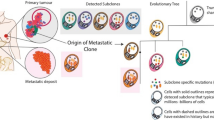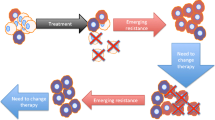Abstract
In this paper we trace the evolution of paradigms concerning the nature of breast cancer and their therapeutic consequences. There is no doubt that the conceptual revolution of about 20 years ago has led to modest gains in survival following the use of adjuvant systemic therapy and the quality of survival by demonstrating the safety of conservative surgical regimens. At the same time, there seems to be a plateau in progress. The results of adjuvant systemic therapy are not as good as anticipated and there are a number of other inconsistencies within the conventional model of biological predeterminism that remain to be explained. We offer up an alternative paradigm that suggests that not all metastases are due to cellular dissemination with late onset local and distant recurrence resulting from a transfection phenomenon, whereby subcellular particles shed by the primary cancer cell are taken up by wandering cells of the monocyte macrophage system and transported to distant sites where the local mesenchymal cells are transfected with the genetic information that activates components of the genome to instruct these plastic cells to express the phenotypic picture of a dedifferentiated breast duct epithelial cell. Such a conceptual revolution will open up the way for a new program of research and the development of therapies based on anti-viral rather than cytotoxic drugs.
Similar content being viewed by others
Abbreviations
- CSF:
-
Colony stimulating factor
- HuMTV:
-
Human homologue of the MMTV
- LTRs:
-
Long terminal repeat sequences
- MMTV:
-
Mouse mammary tumor virus
References
Müller J: Über den feinern Bau und die Formen der krankhaften Geschwulste, Leif. G. Reimer, Berlin, 1838.
Virchow R: 1863–1873 (Cited by de Moulin) Die krankhaften Geschwulste, Hirschwald Publishers, Berlin, 1863–1873; 1.
Halsted WS: The radical operation for the cure of carcinoma of the breast.John Hopkins Hospital Reports 1898; 28:557, 1898.
Baum M: The history of breast cancer. In: Forbes JF ed, Breast Disease, Churchill Livingstone, Edinburgh, pp95–105, 1986.
MacDonald I: Biological predeterminism in human cancer.Surg Gynaecol Obstet 92:443, 1951.
Brinkley D, Haybittle JL: The curability of breast cancer.Lancet 2:95–98, 1973.
DeMoulin D: A Short History of Cancer, Martinus Nyhoff Publishers, Boston, The Hague, Lancaster, 1983.
Fisher B: The surgical dilemma in the primary therapy of invasive breast cancer; A critical appraisal. In: Current Problems in Surgery, Year Book Publishers, Chicago, 1970.
Fisher B, Redmond C, Poisson R,et al: Eight year results of a randomised clinical trial comparing total mastectomy and lumpectomy with or without irradiation in the treatment of breast cancer.N Engl J Med 320:822–828, 1989.
Fisher B, Bauer M, Wickerham DL,et al: Relation of number of positive axillary nodes to the prognosis of patients with primary breast cancer.Cancer 52:1551- 1557, 1983.
Veronesi U, Volterrani F, Luini A,et al. Quadrantectomy versus lumpectomy for small size breast cancer.Eur J Cancer 26:671–673, 1990.
Early Breast Cancer Trialists’ Collaborative Group: Systemic treatment of early breast cancer by hormonal, cytotoxic or immune therapy.Lancet 339:1–15, 71-85, 1992.
Stoll BA, ed: Prolonged Arrest of Cancer, John Wiley, Chichester, 1982.
CRC working party, CRC (King’s/Cambridge) trial for early breast cancer.Lancet ii:55–60, 1980.
Paget S: The distribution of secondary growths in carcinoma of the breast.Lancet 1:571–573, 1989.
Baum M, Berstock DA: Breast cancer, adjuvant therapy. In: Clinics in Oncology, Breast Cancer, WB Saunders, London, pp901–916, 1982.
Henderson IC: Biological variations of tumours.Cancer 69:1888–1895, 1992.
Retsky MW, Swartzendruber DE, Wardwell RH,et al: Is Gempertzian or exponential kinetics a valid description of individual human cancer growth.Medical Hypothesis 33:95–106, 1990.
Koscielny S, Tubiana M, Le MG,et al: Breast cancer; Relationship between size of the primary tumour and the probability of metastatic dissemination.Br J Cancer 49:709–715, 1984.
Breast cancer; Have we lost our way?Lancet 341:343 –344, 1993, Editorial.
Harvey Schipper, Cynthia Goh, Tiak-Um L Wang L: Rethinking cancer; Should we control rather than kill? Part 1.Canadian J Onc 3(3):207–216, 1993.
Harvey Schipper, Cynthia Goh, Tiak-Um L Wang: Rethinking cancer; Should we control rather than kill? Part 2.Canadian J Onc 3(4):220–224, 1993.
Stewart THM, Hollinshead AC, Rahman S: Tumour dormancy; Initiation, maintenance and termination in animals and humans.CJS 34(4):321–325, 1991.
Where can one hope to profitably apply the ideas of chaos?Physics Today, American Institute of Physics, pp24–30, July 1994.
Leslie KB, Lee F, Schrader JW: Intracisternal A-type particle-mediated activations of cytokine genes in a murine myelomonocytic leukemia; Generation of functional cytokine mRNAs by retroviral spacing events.Mol Cell Biol 11:5562–5570, 1991.
Kazazian HH, Wong C, Yousouffian H,et al: Hemophilia A resulting from de novo insertion of L1 sequences represents a novel mechanism for mutation in man.Nature 332:164–166, 1988.
Shimotohno K, Mizutani S, Temin H: Sequence of retrovirus resembles that of bacterial transposable elements.Nature 285:550–554, 1980.
Nusse R, Van Ooyen A, Cox D,et al: Mode of proviral activation of a putative mammary oncogene ( t-1 ) on mouse chromosome 15.Nature 307:131–136, 1984.
Dickson C, Smith R, Brookes S,et al: Tumorigenesis by mouse mammary tumor virus; Proviral activation of a cellular gene in the common integration regionint-2. Cell 37:529–536, 1984.
Kozak CA, Ruscetti SA: Retroviruses in rodents. In: Levy IJA ed, The Retroviruses, volume 1, Plenum Press, NY, 1992.
Keydar I, Chen L, Karby S,et al: Establishment and characterisation of a cell line of human breast carcinoma origin.Eur J Cancer 15:659–670, 1979.
Keydar I, Ohno T, Nayak R,et al: Properties of retrovirus-like particles produced by a human breast carcinoma cell line; Immunological relationship with mouse mammary tumour virus proteins.Proc Natl Acad Sci USA 81:4188–4192, 1984.
Schlom J, Moore DH, Spiegelman S: RNA-dependent DNA polymerase activity in virus-like particles isolated from human milk.Nature 231:97–100, 1971.
Al-Sumidaie AM, Hart CA, Leinster SJ,et al: Particles with properties of retroviruses in monocytes from patients with breast cancer.Lancet ii:5–9, 1988.
Kahl LP, Carroll AR, Rhodes P,et al: An evaluation of the putative human mammary tumour retrovirus associated with peripheral blood monocytes.Br J Cancer 63:534–540, 1991.
Boyd MT, Oscier DG, Maclean N: Detection of retrovirus in patients with myeloproliferative disease.Lancet ii:814–817, 1989.
Gerard GF: Poly(2-o-methylcytidylate) oligo deoxyguanylate, a template primer specific for reverse transcriptase, is not used by DNA polymerase.Biochem Biophys Res Comm 63:706–711, 1975.
Ono M, Kawakami M, Ushikubo H: Stimulation of expression of the human endogenous retrovirus genome related to the mouse mammary tumor virus.J Virol 61:2059–2062, 1987.
Ono M, Yasunga T, Miyata T: Nucleotide sequence of human endogenous retrovirus genome related to the mouse mammary tumour virus.J Virol 60:589–598, 1986.
) Segev M, Hizi A, Kirenberg F,et al: Characterisation of a protein released by the T47D cell line, immunologically related to the major envelope glycoprotein of mouse mammary tumor virus.Proc Natl Acad Sci USA 82:1531–1535, 1985.
Gelmann EP, Lippman ME: The role of oncogenes in human breast cancer. In: Sluyser M ed, Growth Factors and Oncogenes in Breast Cancer, Ellis Horwood, England, 1987.
Nusse R: The activation of cellular oncogenes by proviral insertion in murine mammary cancer. In: Lippman ME, Dickson RB eds, Breast Cancer Cellular and Molecular Biology, Kluwer, Boston, 1988.
Kerr JFR, Wyllie AH, Currie AR: Apotosis; A basic biological phenomenon with wide ranging implications in tissue kinetics.Br J Cancer 26:349, 1974.
Lauder I, Aherne W, Stewart J,et al: Macrophage infiltration of breast tumours; A prospective study.J Clin Pathol 30:563–568, 1977.
Gurdon JB: The generation of diversity and pattern in animal development.Cell 68:185–199, 1992.
Macpherson AJS, Bjarnason I: Colonocytes in Barrett’s metaplasia?Lancet 344:903–904, 1994.
Casimir CM, Gastes PB,et al: Evidence of dedifferentiation and metaplasia in amphibian limb regeneration from inheritance of DNA methylation dedifferentiation and metaplasia in amphibian limb regeneration from inheritance of DNA methylation.Development 104:657–658, 1988.
Davis RL, Weintraub H, Lassar AB: Expression of a single transfected cDNA converts fibroblasts to myoblasts.Cell 51:987–1000, 1987.
Holder N: Organisation of connective tissue patterns by dermal fibroblasts in the regenerating axolotl limb.Development 105:585–593, 1989.
Haggie J, Howell A, Sellwood RA,et al: Fibroblasts from relatives of patients with hereditary breast cancer show foetal-like behaviourin vitro. Lancet 1: 1455–1457, 1987.
Gurdon JB: Nuclear transplantation in eggs and oocytes.J Cell Sci 4(Suppl):287–318, 1986.
Rosenberg SA, Abersold P, Cornetta K,et al: Gene transfer into humans; Immunotherapy of patients with advanced melanoma, using tumor-infiltrating lymphocytes modified by retroviral gene transduction.N Engl J Med 323:570–578, 1990.
Rogers JJ, Young HE, Adkison LR, et al: Differentiation factors induce expression of muscle, fat, cartilage, and bone in a clone of mouse pluripotent mesenchymal stem cells. In press 1995.
Shiramizu B, Herndier BG, McGrath MS: Identification of a common clonal human immunodeficiency virus integration site in human immunodeficiency virus-associated lymphomas.Cancer Res 54:2069- 2072, 1994.
Blair PB: Immunological aspects of the relationship between host and oncogenic virus in the mouse mammary tumor system.Isr J Med Sci 7:161–186, 1971.
Callahan R, Weeks MO, Ohuchi N,et al: Retroviral- related genes, proto-oncogenes, and breast cancer.Immunology Series 43:623–642, 1989.
Pogo B, Wang H, Bleiweiss I,et al: Human familial breast cancers contain mammary tumor viral sequences. Proceedings of the American Association for Cancer Research—Clinical Investigations, Volume 35, p218, March 1994.
Pogo BGT, Wang Y, Bleiweiss I,et al: Presence of MMTVenv gene-like sequences in human breast cancer. Proceedings of the American Association for Cancer Research—Clinical Investigations, Volume 35, p218, March 1994.
Donaldson YK, Bell JE, Ironside JW,et al: Redistribution of HIV outside the lymphoid system with onset of AIDS.Lancet 343:382–385, 1994.
Cline MJ: Monocytes and macrophages. In: Cline M ed, The White Cell, part 3, University Press, Cambridge, Mass, pp459–511, 1975.
Alexander P: The functions of the macrophage in malignant disease.Ann Rev Med 27:207–224, 1976.
Review of mortality results in randomised trials in early breast cancer.Lancet ii:1205, 1984.
Dorsch M, Hock H, Kunzendorf U,et al: Macrophage colon-simulating factor gene transfer into tumor cells induces macrophage infiltration but not tumor suppression.Eur J Immunol 23:186–190, 1993.
Naukkarinen A, Syrjänen KJ: Quantitative immuno- histochemical analysis of mononuclear infiltrates in breast carcinomas; Correlation with tumour differentiation.J Pathol 160:271–282, 1990.
Bröcker EB, Zwadlo G, Holzmann B,et al: Inflammatory cell infiltrates in human melanoma at different stages of tumor progression.Int J Cancer 41:562–567, 1988.
Munn DH, Nai-Kong V Cheung: Phagocytosis of tumor cells by human monocytes cultured in recombinant macrophage colony-stimulating factor.J Exp Med 172:231–237, 1990.
Fontán PA, Amura CR, Sordelli DO: Treatment with a non-steroidal anti-inflammatory agent delays the growth of spontaneous pulmonary metastases of a mammary adenocarcinoma of non-detected immunogenicity.Br J Cancer 66:800–804, 1992.
Gupta V, Rajaraman S, Gadson P,et al. Primary transfection as a mechanism for transformation of host cells by human tumor cells implanted in nude mice.Cancer Res 47:5194–5201, 1987.
MacGregor AN, Alexander M: Formation of tumorlike structures on legume roots byRhizobium. J Bacteriol 105:728–732, 1971.
Van Larebeke N, Genetello BH, Schell J,et al: Acquisition of tumour-inducing ability by non-oncogenic agrobacteria as a result of plasmid transfer.Nature 225:742–743, 1975.
Jen GC, Chilton M-D: Activity of T-DNA borders in plant cell transformation by mini-T plasmids.J Bacteriol 166:491–499, 1986.
Author information
Authors and Affiliations
About this article
Cite this article
Baum, M., Colletta, A. Breast cancer: A revolutionary concept. Breast Cancer 2, 9–18 (1995). https://doi.org/10.1007/BF02966891
Received:
Issue Date:
DOI: https://doi.org/10.1007/BF02966891




